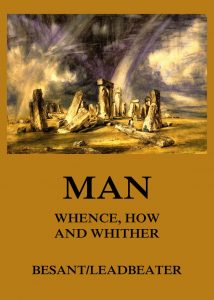Man: Whence, How and Whither – C. W. Leadbeater/Annie Besant
The problem of Man’ s origin, of his evolution, of his destiny, is one of inexhaustible interest. Whence came he, this glorious Intelligence, on this globe, at least, the crown of visible beings? How has he evolved to his present position? Has he suddenly descended from above, a radiant angel, to become the temporary tenant of a house of clay; or has he climbed upwards through long dim ages, tracing his humble ancestry from primeval slime, through fish, reptile, mammal, up to the human kingdom? And what is his future destiny? Is he evolving onwards, climbing higher and higher, only to descend the long slope of degeneration till he falls over the precipice of death, leaving behind him a freezing planet, the sepulchre of myriad civilisations; or is his present climbing but the schooling of an immortal spiritual Power, destined in his maturity to wield the sceptre of a world, a system, a congeries of Systems, a veritable God in the making? This comprehensive survey of the past and future history of mankind was obtained by clairvoyant investigation.
Format: Paperback.
Man: Whence, How and Whither.
ISBN: 9783849674328.
Available at amazon.com and other venues.
Biography of Annie Besant (from wikipedia.com)
Annie Besant, née Wood (1 October 1847 – 20 September 1933) was a British socialist, theosophist, women’s rights activist, writer and orator and supporter of Irish and Indian self-rule.
In 1867, Annie at age 20, married Frank Besant, a clergyman, and they had two children, but Annie’s increasingly anti-religious views led to a legal separation in 1873. She then became a prominent speaker for the National Secular Society (NSS) and writer and a close friend of Charles Bradlaugh. In 1877 they were prosecuted for publishing a book by birth control campaigner Charles Knowlton. The scandal made them famous, and Bradlaugh was elected M.P. for Northampton in 1880.
She became involved with union actions including the Bloody Sunday demonstration and the London matchgirls strike of 1888. She was a leading speaker for the Fabian Society and the Marxist Social Democratic Federation (SDF). She was elected to the London School Board for Tower Hamlets, topping the poll even though few women were qualified to vote at that time.
In 1890 Besant met Helena Blavatsky and over the next few years her interest in theosophy grew while her interest in secular matters waned. She became a member of the Theosophical Society and a prominent lecturer on the subject. As part of her theosophy-related work, she travelled to India. In 1898 she helped establish the Central Hindu College and in 1922 she helped establish the Hyderabad (Sind) National Collegiate Board in Mumbai, India. In 1902, she established the first overseas Lodge of the International Order of Co-Freemasonry, Le Droit Humain. Over the next few years she established lodges in many parts of the British Empire. In 1907 she became president of the Theosophical Society, whose international headquarters were in Adyar, Madras, (Chennai).
She also became involved in politics in India, joining the Indian National Congress. When World War I broke out in 1914, she helped launch the Home Rule League to campaign for democracy in India and dominion status within the Empire. This led to her election as president of the India National Congress in late 1917. In the late 1920s, Besant travelled to the United States with her protégé and adopted son Jiddu Krishnamurti, who she claimed was the new Messiah and incarnation of Buddha. Krishnamurti rejected these claims in 1929. After the war, she continued to campaign for Indian independence and for the causes of theosophy, until her death in 1933.
(The text of the last section was taken from a Wikipedia entry and is available under the the Creative Commons Attribution-ShareAlike License.)
Publisher’s Note: This book is printed and distributed by Createspace a DBA of On-Demand Publishing LLC and is typically not available anywhere else than in stores owned and operated by Amazon or Createspace.

